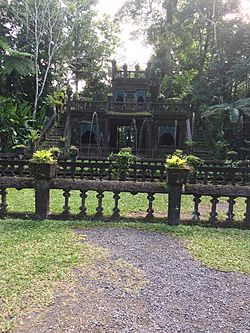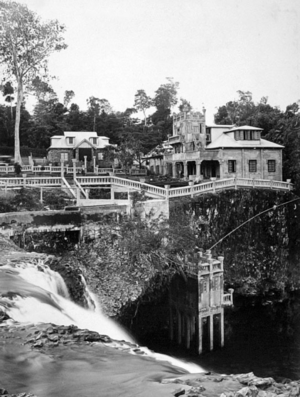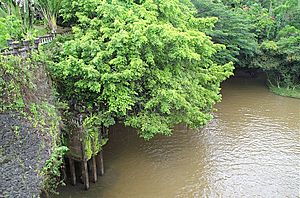Paronella Park facts for kids
Quick facts for kids Paronella Park |
|
|---|---|
|
Paronella Park Refreshment Rooms, 2016
|
|
| Location | Mena Creek, Queensland, Australia |
| Nearest city | Innisfail, Queensland |
| Area | 13 acres (5.3 ha) |
| Established | 1929 |
| Founder | José Paronella |
| Owned by | Mark and Judy Evans |
| Open | All year except Christmas Day |
| Plants | 7,500+ |
| Opened | 1935 |
Paronella Park is a special tourist spot in Mena Creek, Queensland, Australia. It's about 120 kilometers south of Cairns. This amazing park is famous for its beautiful castle ruins, waterfalls, and lush gardens. It was built by a Spanish immigrant named José Paronella.
Contents
History of Paronella Park
Paronella Park was built in the 1930s by José Paronella. He was born in Spain in 1887 and moved to Australia in 1913. José worked hard for 11 years, buying and selling sugar cane farms. He saved enough money to follow his big dream.
While traveling, José found a beautiful forest next to the amazing Mena Creek Falls. He knew this was the perfect place for his dream park.
Building a Dream Park
José returned to Spain and married Margarita, the younger sister of his first fiancée. In 1929, the newlyweds bought the land in Australia. José first built a grand 47-step staircase. This helped move building materials between the upper and lower parts of the park.
The couple built their cottage by hand from stone. They moved in on Christmas Eve. José was inspired by the castles he remembered from his childhood in Spain. He and his workers began designing a fun entertainment area. You can still see their fingerprints in the cement foundations today!
Fun and Entertainment at the Park
The park had a movie theater that turned into a huge ballroom on weekends. Live bands played music for dancing. A giant ball of mirrors spun from the ceiling, reflecting pink and blue lights. It was a dazzling sight!
More than 7,000 trees were planted around the Paronellas' home and castle. This included an avenue of Kauri trees. These trees now stand tall like church spires in a sacred forest.
In 1933, José built North Queensland's first private hydroelectric plant. This plant used the waterfall to create electricity. It powered the park's lights, pumps, and even the cinema. The nearby town of Mena Creek also used some of this power.
The castle grounds were ready to open to the public in 1935. The Paronellas invited everyone to watch movies on Saturday nights. They built tennis courts using crushed termite mounds. There was also a pavilion with balconies, refreshment rooms, and changing rooms for swimmers. Later, a museum opened with a collection of coins, pistols, dolls, and other interesting items.
Challenges and Resilience
The park faced many challenges. In 1946, a flood brought a mass of logs downstream. They destroyed a railway bridge and crashed into the park. The refreshment rooms were ruined. But the Paronellas did not give up. They replanted gardens and repaired what they could. The park reopened just six months later.
José Paronella passed away in 1948. His family, including his wife Margarita, daughter Teresa, and son Joe, continued his dream. Margarita died in 1967, and Joe and his wife Val took over. After Joe's death in 1972, Val and their sons kept the park going until it was sold in 1977.
More disasters struck the park. In 1979, a fire swept through the castle. Only the walls and a turret were left. In 1986, Cyclone Winifred hit the park, causing more damage.
New Beginnings and Restoration
The park changed owners several times. Then, in 1993, Mark and Judy Evans bought it. They saw the park's hidden beauty and wanted to bring José's dream back to life. They worked with the Paronella family to restore the park.
Paths were cleared, buildings were repaired, and trees were identified. A museum was created in the original family home. Even after Cyclone Larry in 2006, the dream continued.
Today, Paronella Park is eco-certified and listed as a heritage site. This means it's protected for its history and natural beauty. Efforts are focused on keeping the park special for many years to come.
Hydroelectric Power at Paronella Park
In 1933, José Paronella built a hydroelectric plant at the park. It was the first privately owned one in Queensland. This plant used the power of the waterfall to create electricity. It supplied power for the park's lights, pumps, and even the cinema. The nearby town of Mena Creek also used some of this electricity.
The original plant eventually stopped working. However, in 2009, the park completed a full restoration of the plant. Now, Paronella Park runs entirely on clean hydroelectric power. Any extra electricity produced is even sent back to the local power grid. This makes the park very environmentally friendly.
Activities for Visitors
Today, visitors to Paronella Park can enjoy several guided tours. These tours share José's amazing story and show off the park's highlights, both day and night.
The Dream Continues Tour
This is a 45-minute guided walk. Tours start every half-hour from 9:30 a.m. until 4:30 p.m. Your guide will show you the park's special features. They will also tell you more about José Paronella’s ideas for the site.
The Darkness Falls Tour
This is a one-hour night tour of the park. It starts at 6:20 p.m. During busy times, there's an extra tour at 8:30 p.m. Seeing the park at night is a unique experience.
Self-guided Botanical Walk
You can also explore the park on your own with a self-guided tour. A 16-page booklet helps you learn about the park's many plants. Different tree species are marked throughout the park.
Awards and Recognitions
Paronella Park has received many awards for its beauty and history. In 2004, it was named Queensland's top significant attraction by Queensland Tourism. It also won an "Emerging Business" award in 2004 from the Queensland Government.
In 2009, Paronella Park was voted the Number One "Must Do" in the RACQ 150 Must Do competition. Also in 2009, as part of the Q150 celebrations, Paronella Park was named one of the Q150 Icons of Queensland. It was recognized for its important role as a special "location" in the state.
See also
 In Spanish: Parque Parnoella para niños
In Spanish: Parque Parnoella para niños





